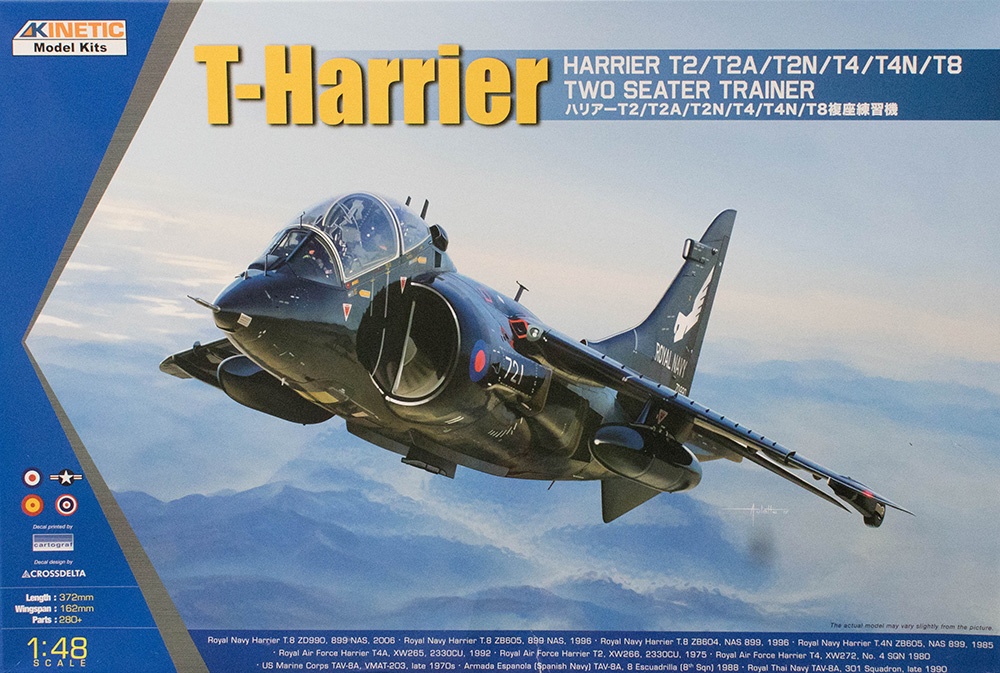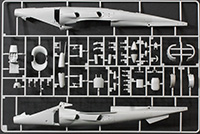
Kinetic 1/48 T-Series Harrier Two-Seat Trainer Kit First Look
By Michael Benolkin
| Date of Review | October 2017 | Manufacturer | Kinetic |
|---|---|---|---|
| Subject | T-Series Harrier Two-Seat Trainer | Scale | 1/48 |
| Kit Number | 48040 | Primary Media | Styrene, Photo-Etch |
| Pros | See text | Cons | See text |
| Skill Level | Experienced | MSRP (USD) | $39.99 |
First Look
 |
 |
 |
 |
 |
 |
 |
The Harrier first started as the P.1127 Kestral, which was the early concept for a Vertical Take-Off and Landing (VTOL) tactical aircraft. First flown in 1960, the aircraft was powered by a new turbofan engine, the Rolls Royce Pegasus and engine thrust alone lifted the aircraft and accelerated it into forward flight using four vectored thrust ducts. Evaluations of the Kestral led to an improved airframe that became the Harrier GR.1 in the UK and AV-8A in the USMC. Incremental improvements to the GR.1 included a laser rangefinder, electronic warfare equipment, and additional weapons capabilities, this version being designated GR.3. Of course, an aircraft this different required a dedicated trainer to transition pilots into VTOL flight operations.
While much can be written about the Harrier in combat over the Falklands (and much has been so written), I can remember when the AV-8A was still in early flight test at Patuxent River. Just before I was stationed in the DC area, the standing tradition of an Army-Navy game played at the Naval Academy included a fly-by of everything the Navy and Marines had available including the latest aircraft from Pax River. As the story was related to me a few weeks afterwards, the usual fly-through commenced 'over' (into) the stadium with an F-8 Crusader, F-4 Phantom II, A-4 Skyhawk, etc., blowing through to the delight of the crowd. Suddenly a small and loud jet aircraft zoomed into the middle of the field, stopped, did a 360 degree turn in the hover, then zoomed back out of the stadium straight up. This was the first time most of these folks had seen a Harrier and every jaw was dropped squarely on the deck. That aircraft did everything a jet fighter was never supposed to do and it might has well have been a flying saucer as far as the spectators were concerned. The Harrier had been 'properly' introduced.
Here's an interesting new kit from Kinetic, the Harrier trainer variants for Hawker-produced Harriers. When you look inside the box, you can understand why the title of this kit is nearly a paragraph long. Kinetic has engineered this kit to render a wide range of trainer variants out of this box. The kit is molded in gray styrene and presented on eight parts trees plus two trees of clear parts, and one fret of photo-etched parts. The surface details are sharp, the panel lines and rivet details are also sharp and not overdone.
Among the features and options in this kit:
- Detailed ejection seats with photo-etched crew restraints
- Detailed front and rear cockpits
- Front and rear windscreens
- Positionable canopies
- Choice of small or large ventral speed brake
- Choice of open or closed auxiliary intake doors
- Exhaust nozzles are engineered to pivot together
- Positionable trailing edge flaps
- Positionable ailerons
- Positionable stabilators
- Positionable rudder
- Choice of 'normal', tall, or RWR vertical stabilizers
- Choice of pointed or laser sensor nose
- Choice of pointed or RWR tail cone
- Detailed landing gear
- Optional air refueling probe
- Choice of antennas depending on variant being built
Weapons/stores options include:
- Choice of ventral gun packs or ventral strakes
- 2 x 190 gallon external tanks
- 2 x 100 gallon external tanks
Marking options include:
- Harrier T.8, ZD990/721, 899 Sqn, FAA, RNAS Yeovilton, 2004-5
- Harrier T.8, ZB605/720, 899 Sqn, FAA, RNAS Yeovilton, 1996
- Harrier T.8, ZB604/722, 899 Sqn, FAA, RNAS Yeovilton, 1996
- Harrier T.8, ZB605/718, 899 Sqn, FAA, RNAS Yeovilton, 1985
- Harrier T.4A, XW265/W, 233 OCU, RAF Wittering, 1992
- Harrier T.4A, XW266/51, 233 OCU, RAF Wittering, 1975
- Harrier T.4, XW272/Z, IV(AC) Sqn, RAF Guetershloh, 1980
- TAV-8A, 159382, KD/04, VMAT-203, MCAS Cherry Point, 1970s
- TAV-8A, 159379, KD/06, VMAT-203, MCAS Cherry Point, 1970s
- TAV-8A, 159380, KD/01, VMAT-203, MCAS Cherry Point, 1970s
- TAV-8A, 159383, KD/05, VMAT-203, MCAS Cherry Point, 1970s
- TAV-8A, 159384, KD/12, VMAT-203, MCAS Cherry Point, 1970s
- TAV-8A, 159385, KD/03, VMAT-203, MCAS Cherry Point, 1970s
- TAV-8S, 01-807, 8 Sqn, Spanish Navy, 1988
- TAV-8S, 01-808, 8 Sqn, Spanish Navy, 1988
- TAV-8S, 159563, 3101, 301 Sqn, Royal Thai Navy, 1990s
- TAV-8S, 159564, 3102, 301 Sqn, Royal Thai Navy, 1990s
The decal artwork comes on a huge sheet that was printed by Cartograf.
While the kit looks great out of the box, the true test is getting it on the bench. From what I've seen online by those who've built this before we received our copy, the kit goes together beautifully and without any challenges. We'll get this on the bench as soon as possible as well.
While this kit does borrow some parts trees out of the previous Sea Harrier releases (pylons, external tanks, etc.), some of the new parts might make one wonder if we'll be seeing an AV-8A/C, GR.1/GR.3 in our future. Wouldn't that be outstanding!
My sincere thanks to Lucky Model for this review sample!







